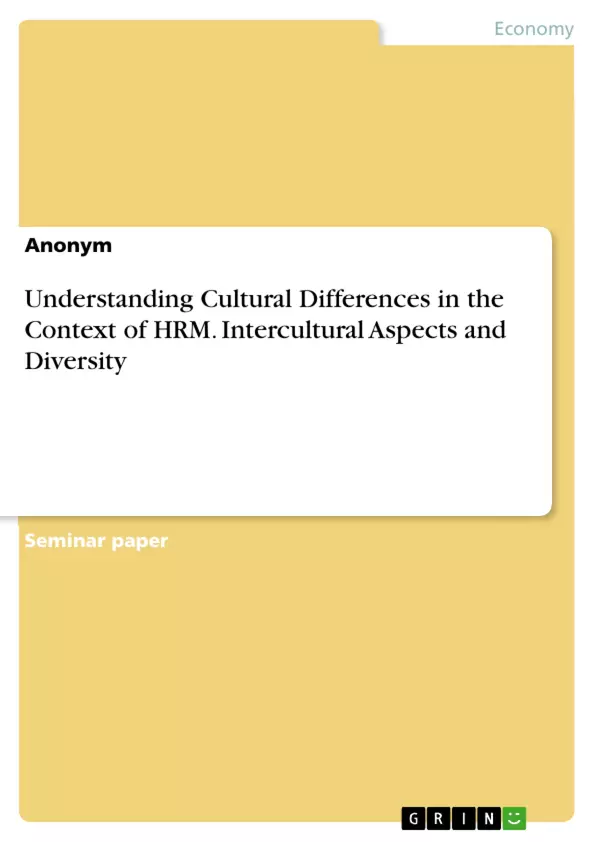HR must be properly trained to observe, analyze and overcome cultural differences. In this paper, an overview of culture and how it can be understood in the context of Human Resources management (HRM) is given. Starting off, a definition of the term “culture”, followed by briefly explained theoretical framework regarding culture theory by Geert Hofstede and Edgar Schein are presented. Those frameworks will help to understand the necessity of diversity management in form of training in HRM, where multiple examples are depicted. Two merger case studies – a failure and a success - of the automobile industry will then be analyzed to emphasize the importance of acknowledging cultural differences in the business world. To conclude this term paper, a summary of key facts regarding the significance of culture in the context of HRM is presented.
When hiring new employees, Human Resources (HR) has the duty to help employees to adapt to their new job and new environment. Depending on the employee, adapting can become harder, if the employee is confronted with cultural differences. The difference could be solely of organizational, but if the employee is e. g. from another country and/or continent, they could experience a culture shock, which would result in a decreased employee productivity, engagement and success, if not handled properly by HR.
Inhaltsverzeichnis (Table of Contents)
- Introduction
- Understanding Culture in the Context of HRM
- Definition of Culture
- Hofstede's Dimensions of Organizational Culture
- Schein's Levels of Organizational Culture
- Diversity Management
- Definition of Diversity and Diversity Management
- Key Components to manage Cultural Diversity
- Training - Managing and valuing Diversity (MVD)
- Attitude training - Raising cultural awareness
- Skill training – nonverbal communication
- Cultural Diversity in Cross-Border Mergers
- Merger Case Studies
- HRM - Managing Cultural Differences in Mergers and Acquisitions (M&A)
- Daimler-Chrysler
- Volkswagen-Skoda
- Conclusion
- Appendix
- Sources
Zielsetzung und Themenschwerpunkte (Objectives and Key Themes)
The aim of this paper is to provide an overview of culture and its role in Human Resource Management (HRM). The paper focuses on understanding the definition of culture, exploring theoretical frameworks for analyzing organizational culture, and demonstrating the significance of diversity management in HRM. It examines the impact of cultural differences in cross-border mergers and analyzes two case studies, one successful and one unsuccessful, to highlight the importance of recognizing and managing cultural differences in the business world.
- Definition and understanding of culture in the context of HRM
- Theoretical frameworks for analyzing organizational culture (Hofstede's dimensions, Schein's levels)
- The importance of diversity management in HRM
- The impact of cultural differences in cross-border mergers and acquisitions
- Case studies analyzing the success and failure of mergers in the automobile industry
Zusammenfassung der Kapitel (Chapter Summaries)
- Introduction: Introduces the topic of cultural differences in the context of HRM, highlighting the importance of HR's role in adapting employees to new environments. It emphasizes the potential impact of culture shock on employee productivity and success.
- Understanding Culture in the Context of HRM: This chapter defines the term "culture" and explores its various aspects, focusing on its relevance to HRM. It also examines the concepts of corporate culture and organizational culture, providing a foundation for understanding cultural dynamics in the workplace.
- Definition of Culture: This section delves deeper into the definition of "culture," presenting both general and specific definitions. It explores different aspects of culture, including art, religion, tradition, and food, highlighting their significance in understanding cultural nuances.
- Hofstede's Dimensions of Organizational Culture: This section introduces Geert Hofstede's influential framework for analyzing organizational culture across different countries. It explains each of Hofstede's six dimensions, including Power Distance, Uncertainty Avoidance, Individualism vs. Collectivism, Masculinity vs. Femininity, Long-Term vs. Short-Term Orientation, and Indulgence vs. Restraint. These dimensions provide insights into how different cultures approach work, decision-making, and values.
- Schein's Levels of Organizational Culture: This chapter (not included in the text provided) would likely explore Edgar Schein's framework for understanding organizational culture. Schein's model typically distinguishes between three levels of culture: artifacts, espoused values, and basic underlying assumptions. This approach provides a different lens for analyzing cultural dynamics within organizations.
- Diversity Management: This chapter focuses on the definition of diversity and diversity management in HRM. It explores key components for managing cultural diversity effectively and outlines different types of training programs, including attitude training and skill training, to promote cultural awareness and sensitivity in the workplace.
- Cultural Diversity in Cross-Border Mergers: This chapter examines the challenges and opportunities presented by cultural differences in cross-border mergers and acquisitions (M&A). It highlights the importance of understanding and addressing cultural variations to ensure successful integration.
- Merger Case Studies: This section delves into two specific case studies of mergers in the automobile industry, one successful and one unsuccessful. It analyzes these cases to demonstrate how cultural differences played a significant role in the outcome of the mergers, illustrating the importance of cultural awareness and management in M&A activities.
Schlüsselwörter (Keywords)
The core concepts of this paper revolve around understanding culture in the context of Human Resource Management (HRM), with specific focus on cultural differences and their implications for organizational dynamics and cross-border mergers. Key themes include organizational culture, diversity management, cultural awareness, cultural sensitivity, Hofstede's dimensions, and the significance of these factors in ensuring successful integration in mergers and acquisitions.
- Arbeit zitieren
- Anonym (Autor:in), 2021, Understanding Cultural Differences in the Context of HRM. Intercultural Aspects and Diversity, München, GRIN Verlag, https://www.grin.com/document/1430343



